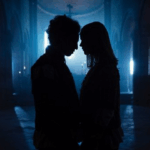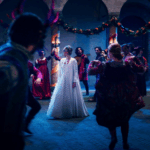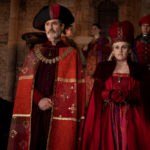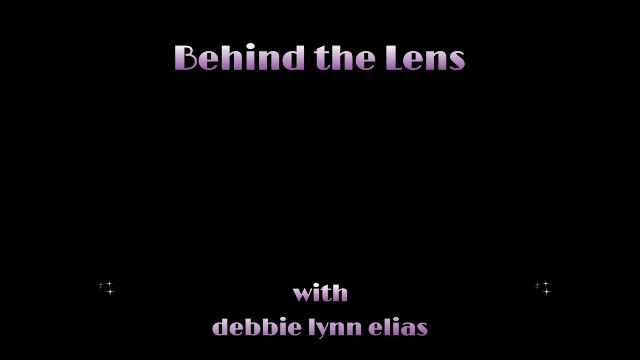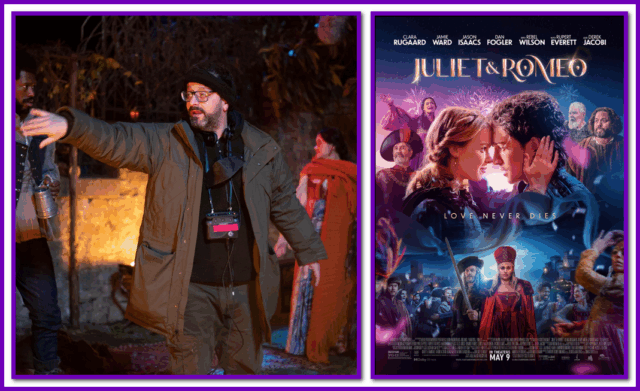
An exclusive interview with one of my favorite filmmakers, TIM BOGART talks about the magic of making the musical JULIET & ROMEO. (William Shakespeare has never looked or sounded so good!)
SYNOPSIS: Set in 1301 at the end of Medieval times, the JULIET & ROMEO Franchise finds our most famous Star-Crossed lovers turning the tides on the history Shakespeare based his own story on, as they reveal the truth to the very future of the Empire. But the biggest twist in this most beloved of tales, is leaving the poetry of Iambic Pentameter in the past, for the original Pop Music that rockets these ever-present themes right to the heart of our characters in the most surprising, and perhaps most powerful way that has ever been seen, or heard, before… The greatest love story of all time, set to the greatest music of our time.
Written and Directed by TIMOTHY SCOTT BOGART, JULIET & ROMEO stars Clara Rugaard, Jamie Ward, Jason Isaacs, Rebel Wilson, Rupert Everett, Dan Fogler, Derek Jacobi, Rupert Graves, Ferdia Walsh-Peelo, Tayla Parx, Ledisi, Dennis Andres, Martina Oritiz Luiz, Alex Grech, and Max Parker.
My admiration for writer/director TIM BOGART is no secret. His last film, Spinning Gold, is one of my all-time favorite films (and soundtracks) thanks to the music, the production numbers, the exemplary production design, beautiful lensing, high polish, casting, and a personal story that only Tim Bogart could tell about his legendary father. Tim has proven himself to have a great knack for musicals and showmanship, so imagine my absolute glee when I learned that his follow-up film to Spinning Gold would be a musical. And then I screened JULIET & ROMEO. Tim has spun gold once again! And while not for everyone, JULIET & ROMEO is a beautiful film that celebrates the bold vision of Tim Bogart.
From Dante Ferretti’s luscious production design to Luciano Capozzi’s costuming to cinematographer Byron Werner’s gorgeous lighting and lensing, the film sparkles and shines. Then there are multiple production numbers complete with all original songs and a luscious score that ties the musical themes together. Tim’s brother Evan Bogart, along with fellow composer Justin Gray, deliver the score and all of the original songs, giving JULIET & ROMEO the feel of an authentic MGM musical with the songs serving as dialogue, propelling the story along. The lensing and editing of the production numbers are superbly staged and executed, as are the montages peppered throughout. And don’t think I didn’t catch the overhead Busby Berkeley-esque shots of some of those production numbers, showcasing some well-choreographed dances. Everything is just wow.
But before we even get to the visual mastery, there is Tim’s script. Talk about original! I love what he has done to spin this tale, taking some literary license and giving it a female perspective with a unique ending. While some may disagree, for my money, standout is Tim’s blending of Shakespeare’s iambic pentameter and Elizabethan phrasing with contemporary colloquialisms and cadence. It’s a balancing act to be sure, and one that I think Tim has mastered. And Tim doesn’t forget to include many of Shakespeare’s most famous idioms/quotes from the play Romeo and Juliet (e.g., “What’s in a name?”), which Tim has directed on stage.
Reteaming with Byron Werner as his cinematographer is one of the big coups with JULIET & ROMEO, as is the casting with his Spinning Gold gang of Jason Isaacs, Dan Fogler, Tayla Parx, and Ledisi. Hearing Parx sing is magical. The entire cast is first-rate, from Clara Rugaard, who lights up the screen as Juliet, and Jamie Ward as Romeo, to Isaacs as Lord Montague, to Rebel Wilson (who comes across more as a wicked, nasty stepmother than Juliet’s mother), to Rupert Everett as Lord Capulet. Dan Fogler helps provide comic relief as The Apothecary, but a real joy is Derek Jacobi as The Friar. Not to be missed are Romeo’s band of brothers, who bring to life a camaraderie and true brotherhood that the four boys share throughout the film.
With all of this in mind, TIM BOGART and I reconnected to talk about this musical undertaking and break it all down for you, starting with the fresh take on the classic tale. Focusing on the feminine perspective and Juliet’s storytelling POV, Tim makes her a proactive character. Having directed Shakespeare’s plays on stage, including Romeo and Juliet, in our conversation, Tim emphasized the importance of adapting Shakespeare’s works and the challenges of portraying Juliet as a more active character. Particularly challenging for Tim was incorporating iambic pentameter and idioms from the original play while making it accessible for today’s audience. As you can see on watching the film, the production design, costumes, and lighting were meticulously crafted for period authenticity of 1301. JULIET & ROMEO is truly a bold vision.
With his unique approach by focusing on Juliet as a more active and empowered character, contrary to her traditionally passive role in Shakespeare’s original play, he not only contemporized the language while retaining some of Shakespeare’s iambic pentameter and iconic phrases like “What’s in a name?”, but also considered the historical context, noting that in 1301, a 14-year-old would be midway through their expected lifespan. Tim even went to his daughter during the writing process to ensure the characters felt authentic and relatable to younger audiences. By giving Juliet more agency and exploring the nuanced relationships between the Montague and Capulet families, Bogart created a fresh perspective on the classic love story that feels more modern and complex.
Tim emphasized the importance of authenticity and character relationships, particularly among Romeo’s friend group. He noted that creating a realistic dynamic between the young characters was crucial. By showing them as a tight-knit group with nuanced interactions, like their scenes in the market square that feel like typical young people hanging out, he aimed to make the characters feel genuine and relatable. Focusing on authenticity and finding actors who could bring a fresh, contemporary perspective to the classic characters, he cast Clara Rugaard as Juliet, emphasizing her ability to portray a more active, empowered version of the character, while Jamie Ward slips into character as Romeo. For the supporting roles, Tim carefully selected actors like Nicholas Perdany as Mercutio, Max Parker as Benvolio, Alex Grech as Tomaso, and Zac Bellward as Leopold to create a dynamic group of friends around Romeo. He was particularly interested in showing the complexity of relationships, especially with characters like Tybalt, beautifully played by Ferdia Walsh-Peelo, who brings ambiguity and nuance to the traditional rivalry between families. The casting process was driven by Tim’s desire to make the characters feel authentic, relatable, and true to the historical context of 1301, while also giving them a contemporary emotional depth that modern audiences could connect with.
One of the most exciting artisans to join this production of JULIET & ROMEO is the legendary three-time Academy Award-winning production designer Dante Ferretti. Struggling to find a production designer in Italy, Tim was thrilled when Ferretti agreed to join the project. (You’ll love hearing Tim tell the story about getting Ferretti for this film.) They met in Sardinia, where Dante created intricate designs like the “Da Vinci” mechanism for moving characters, always focusing on historical mechanics and design of the time. As you listen to our conversation, you’ll hear Tim go into great detail about working with Ferretti. Another great addition to the production team is costume designer Luciano Capozzi. For Capozzi, the focus was on creating costumes that reflected the economic status and origin of each character. They used fabrics from Asia and around the world to show Verona as a trading place, and carefully layered different materials to represent social classes – silk and satin for wealthy families, heavier cottons for townspeople. Each costume was meticulously designed to give hundreds of extras their own unique “inner life” and historical authenticity.
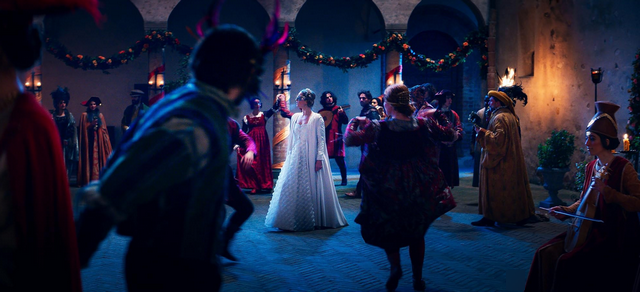
With all of the attention to detail and historical accuracy in production design, costuming, casting, and story, visual grammar is crucial to capture all of the grandeur and emotion, which is where Tim’s “right hand”, cinematographer Byron Werner, gets to shine. Again, focusing on authenticity and creating a realistic world for JULIET & ROMEO, they spent over six months in pre-production, carefully selecting locations that would feel genuine to the 1301 time period. Their key approach was creating a visual style that felt inner-voiced and real, not like a stylized musical where characters know they’re in a musical. For lighting, they were particularly mindful of creating realistic illumination for a time without electricity, using only fire and moonlight. Byron used large crane shots with custom moonlight setups to capture this authenticity. Tim emphasized that Byron wasn’t just executing Tim’s vision, but infusing it with his own unique perspective. Their collaboration just goes stronger with each film they do together. Here, they were committed to creating a visual environment where you could turn the camera anywhere and feel the genuine space and time. This included capturing small details like actors’ breath being visible in the cold castle, which they deliberately kept in the film to enhance realism. The collaboration was so close that Tim says the film “could not have been done without Byron.”
And of course, Tim and I take a look at the editing by editors Camilla Toniolo and Andrea Bottari, who weave their own magic by not only establishing pace and building tension and joy, but in crafting some magical and breathtaking montages.
To call JULIET & ROMEO an ambitious project is an understatement. In making this film, Tim Bogart learned to trust his personal gut and boldness as a filmmaker. He realized that being willing to take creative risks and go “out on the wire” is crucial to artistic growth. Growing as a filmmaker with lessons learned on Spinning Gold, Tim readily admits that with JULIET & ROMEO, he has grown even more, gaining even more confidence in pursuing provocative and unconventional choices, believing that by staying true to his vision, he can create something unique and meaningful.
And this is just the tip of the iceberg of our conversation! So sit back, relax, and
TAKE A LISTEN. . .
by debbie elias, exclusive interview 05/05/2025
JULIET & ROMEO is in theatres now!

